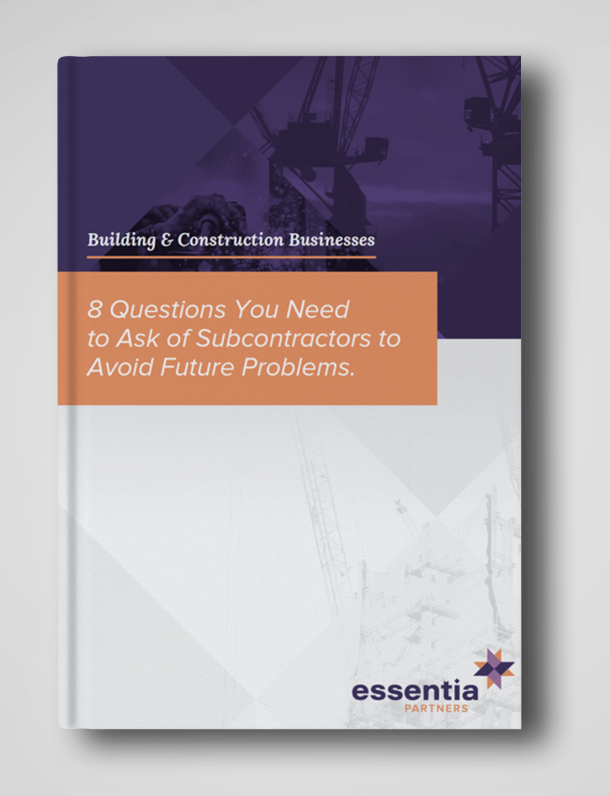
- IN Community
Building & construction businesses: 8 areas you need to review with subcontractors & employees to avoid future problems
Subcontractors vs employees: who’s entitled to what and what are your obligations?
As you look to protect what you’ve built, it can be concerning to be constantly reminded of the difficulties of engaging subcontractors in the building and construction industry.
Compliance matters are becoming increasingly complex as changes are made to regulations for building businesses dealing with subcontractors. So it’s important to know where you stand.
Running a small or medium building and construction business is challenging and risky enough without adding problems with subcontractors to the mix.
Getting it right and managing a well-run business with a team all pulling together can be hugely rewarding financially and professionally.
We’ve identified eight areas of your arrangements with subcontractors that you should review to keep relationships on track and your business thriving.
Before we get to those eight areas, let’s take a quick look at how we’ve arrived at this point.
Compliance matters: why you need to review
We are indeed in a time of “compliance”.
The Australian Taxation Office and Revenue NSW, along with various other government bodies, are hardening up on their previous stance of providing assistance to small businesses.
They are turning their attentions to compliance (that is, audits and reviews) and are knocking back claims, sometimes purely because of poor record-keeping.
And you may have heard how employers are being sued by their contractors who, after the relationship ends, are claiming that they should have been made employees; many are claiming unpaid super, annual leave, long service leave and other employment entitlements.
Every good house is built on a strong foundation and the same goes for a good business.
You need the basics to be right and have effective internal procedures in place to help protect your business from the growing risks in the building and construction industry.
Now is as good a time as any to review where your business is at with regards to your subcontractors and employees – and to make sure you’ve covered yourself.
Subcontractors vs employees: 8 fundamental foundations to review
-
1. Is your contractor really an employee?
Relationships between employers and employees are different to those between employers and contractors.
At the two ends of the spectrum, it’s easy to see the difference:
- Employees work in your business; perform their work as directed by you; are paid by you on an hourly basis; and have employment rights such as annual leave, personal leave and long service leave.
- Contractors work in their own business, which provides services to your business. They have the power to delegate work to others; employ others to do the work; are paid for a result (not on an hourly basis); use their own equipment; control the way the work is performed; take their own commercial risks on the job with profit or loss; and are labile for the cost of rectifying defective work.
It’s important to hire employees on an employment basis and contractors on a contract basis.
Difficulties may arise where a relationship between two parties has a flavour of both. It’s the overall balance of factors that will ultimately decide which side of the fence your relationship falls onto.
- 2. Have you documented your relationship?
Once you’ve established the relationship with your employee or contractor, you should have a legal contract drawn up detailing the terms and conditions of your relationship.
A good HR or construction lawyer should be able to draw up contracts for you to use as templates for future employees or contractors.
- 3. Do subcontractors have the appropriate insurance and licences?
Have you asked your contractor for a copy of their insurances (including certificate of currency) and licences?
They should be current, valid, in the correct name and, of course, specifically cover the right areas of work. This latter requirement will depend on what work they’re doing for you.
-
4. Have you considered only engaging with contractors that run their business through a Pty Limited company?
A Pty Limited company needs to have its own insurance (such as worker’s compensation insurance) and pay their employees Superannuation Guarantee Charge.
These requirements lessen the obligations on your own business.
It’s certainly easier to deal with contractors who operate their business through a company but it doesn’t alleviate all of your obligations.
-
5. Is the Superannuation Guarantee Charge applicable?
Just because you’ve engaged an individual as a contractor rather than an employee doesn’t automatically mean you don’t need to pay superannuation guarantee on their behalf.
Some contracts, where the subcontracting work is wholly or principally for labour by a specific person, require the employer to pay superannuation for that contractor.
Check with your accountant.6. What payroll tax obligations apply?
Unfortunately, there is no streamlined payroll approach when it comes to dealing with contractors.
The way that worker’s compensation, superannuation and payroll tax apply to contractors is all different!
A common misconception is that if you engage a contractor that is a Pty Limited company, then you don’t need to include them in your payroll tax calculations. This is unfortunately incorrect.
All payments under a relevant contract need to be included unless the arrangement with the contractor falls specifically under an exclusion.
Payroll tax should be considered before you engage a contractor. If you’re going to be liable for it, take it into account when negotiating the terms and conditions of the contract.
-
7. What documentation and record-keeping is required?
Record-keeping may be as boring as watching paint dry; but it’s also vitally important.
In fact, it could save your bacon if you end up with a dispute between two parties, or are audited for tax, GST or payroll tax purposes.
As an employer in the building and construction industry, you need to:
- Provide tax invoices
- Provide substantiation for payroll tax purposes (if you are claiming a particular exemption, you may need to go further than just the format of the invoice supplied by the contractor)
- Check ABN lookup to check a contractor’s ABN and GST registration
- Keep other records to substantiate that the payment to the contractor is wholly deductible
- Report TPars (Taxable Payments annual report) to the ATO: this will include some contractors, but maybe not all.
- Provide subcontractor statements
That may sound like a lot but the good news is that once your systems are set up, the compliance part of dealing with contractors, whilst ongoing, will be easier and more streamlined.
- 8. Do their references check out – and what about cash retention?
At the end of the day, builders engage contractors because they need good quality work done.
You’ll develop relationships with subcontractors over time and get to know the way they work and the quality of the work that can be expected.
However, when engaging a contractor for the first time, don’t hesitate to ask for referrals from your network and for references from a new subcontractor.
Their quality of work and professionalism will reflect positively on your business.
Note that, if your business has been engaged on a project valued over $20m and the contract provides for cash retention, this needs to be held in a trust account by the head contractor.
So you should also consider whether to hold cash retention on your subcontractors.
Take the first step to protecting your business
Successful building and construction business owners surround themselves with knowledgeable people they can learn from, who can assist them to implement changes and add checks and balances into their systems.
You need a good accountant, a good bookkeeper, and access to good legal advice. These advisors should understand your industry, understand you, and understand your unique business.
Start improving the processes today and reap the benefits tomorrow. Contact us today.


